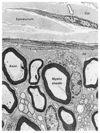Nerve tissue Flashcards
What are the two types of cells in the Nervous system?
-neurons or nerve cells -supporting cells
What is the difference between the nerve cells of the PNS and CNS?
PNS - Schwann cells surround nerve processes - Satellite cells - surround nerve cell bodies in ganglia -CNS - glial cells
Describe some basic information of the neuron.
-structural functional unit of the NS -10 billion in humans -consist of central process- axon -peripheral process - dendrite
Do neurons replicate?
no
What is the name of the neuron cell body
Perikaryon

Describe some of the structural components for the perikaryon.
-Nissl bodies -Mitochondria -large peripheral GA
What are Nissl bodies?
-stacks of RER -extend into dendrites -depend on the cell body for maintenance

Where can you find Nissl bodies?
In the dendrites but not the axons
Describe the parts of the neuron.

What carries information to the cell body
dendrites
What has a greater diameter dendrite or axon?
dendrites
Are dendrites myelinated?
no
What are the purpose of arbonizations called dendritic trees on dendrites?
-allows for a greatly increase in the receptor surface of the neuron
Where are axons origins on the nerve cell?

Axon Hillock
What are the components of the Axon Hillock? What organelles are not present here?
In- microtubules, neurofilaments, mitochondria, vesicles, terminal arborizations Not present - Nissyl (RER) and Golgi
What is the purpose of the axons?
carry information from the cell body.
How many axons and dendrites per neuron?
1 axon and may have numerous dendrites
Axolemma
axon plasma membrane
Axoplasm
axon cytoplasm lacks a golgi complex but contains SER, RER and elongated mitochondria - lacks a golgi apparatus
Golgi Type I neurons
- motor nuclei of CNS - axons more that 1 meter long ex. muscle
Golgi Type II neurons
- golgi cells in the cerebellum - have short axon - axon branched near target organ
Where do sensory neuron travel?
receptor to CNS
Where do motor neuron travel?
CNS or ganglia to effector cells
What are interneurons?
connections between neurons and include internuncial, central and intercalated neurons, (99% of neurons). They regulate signal transmission between neurons.



























